World War
Two
15th Field Artillery
Regiment
INDIANHEADS
World War Two
On 10 October 1940, the 15th Field Artillery (FA) Regiment was reorganized at Fort Sam
Houston, TX, as the 15th FA Battalion (Bn). The 15th FA Bn was ordered to Camp McCoy, WI,
on 16 October 1942, for intensive training with the 2nd Infantry Division.

'A'
Battery, 15th FA Battalion, Second Infantry Division
Camp McCoy near LaCrosse, Wisconsin
This
photo was taken just before A Battery
shipped to Ireland in October 1943
Photo: Virgil Smith (7th from left, top row)
Click
thumbnail images to enlarge
 Virgil
Smith added the following information to the photo above:
Virgil
Smith added the following information to the photo above:
"The artillery units at Camp McCoy were the 15th FA BN, the 37th FA
BN, and the 12th FA BN. Each unit was assigned to support a regiment of
the infantry- the 15th was assigned to the 9th Infantry Regiment.
Other
infantry regiments were the 23rd and 38th. I was forward observer and
was always attached to 'A' Company of the 9th and called artillery fire
for the point company of each attack."
Virgil Smith
1943
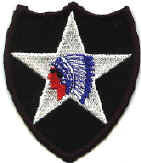
Second Infantry
Division patch
Image: Dennis Heidbreder

9th Infantry
Regiment
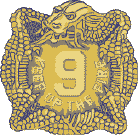
"On Dec. 7,
1941, the 2nd Division units were on maneuvers at Ft. Sill, Okla. With
the news from Pearl Harbor, the division packed up and made a forced
march back to Ft. Sam Houston, TX. We stayed there for several months
while we were given all new equipment, trucks, guns, uniforms, etc. We
traded the old Dodge half-tons for 2-1/2 ton GMCs to pull the new 105
howitzers which replaced the French 75s.
The division then went by
truck to Camp McCoy, Wis., where we were first to occupy the structures
there. We were trained on the new howitzers and then marched to the
Upper Peninsula of Michigan to learn to ski and use snow shoes. It was
cold there. One week it was 52 below zero at night, with daytime highs
about 22 below. We had the clothes and equipment to withstand that
weather comfortably. I remember one night I climbed into sleeping bag
with clothes on and tried to sleep on a bench in the back of a truck. I pulled
pants down over my feet. It was still too cold so I tumbled to floor. I was
still freezing, so I tumbled over the tailgate into the snow. I warmed
up immediately and fell asleep. We returned to Camp McCoy in the
spring and awaited shipment to Belfast, Ireland."
Virgil
Smith 6957947
Written: January 2002
Movement Overseas
Movement overseas came on
8 October 1943, when the 15th FA Bn sailed from New York onboard the SS Hawaiian
Shipper for Belfast, Northern Ireland, where it trained for several months. Embarkation for Porthcawl, Wales, followed on 17
April, 1944. As part of the 9th Regimental Combat Team (9th
Infantry Regiment & 15th FA Bn), the 15th FA Bn landed at Omaha Beach near St.
Laurent-Sur-Mer, France, on D Day +1 (7 June 1944). The 15th FA Bn fought for 73 straight
days in support of the 2nd Infantry Division throughout Normandy without a break. Their
first break in the combat action came on 19 August 1944, when the 15th FA Bn was ordered
to move 220 miles and occupy firing positions for the battle against the German fortress
at Brest, France. The battle that ensued was bloody and hard fought by all elements of the
2nd Infantry Division including the 15th FA Bn. On 26 September 1944, five officers and 42
enlisted men of the 15th FA Bn were presented Bronze Star Medals, by the Division
Commander, for their actions since D Day
+1
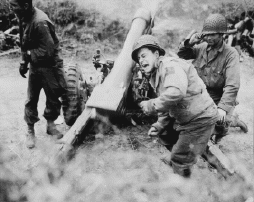
Credit: National Archives
Following this, a 770 mile road march began on 27 September 1944 and carried the 15th FA Bn to Schoenberg, Belgium. By 4 October 1944, the 15th FA Bn crossed into Germany and opened fire on elements of both the 2nd and 3rd SS Panzer Grenadier Divisions. On 17 December 1944, the 15th FA Bn fought as an integral part of the 2nd Infantry Division’s attack on the Siegfried Line near Elsenborn. By 1 February 1945, the area known as Heartbreak Crossroads was taken after a multi-divisional battle.
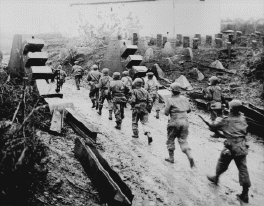
Credit: National Archives
On 21 March 1945, the 15th FA Bn crossed the Rhine River into Germany on a pontoon bridge near Remagen, and took up firing positions near the town of Leutesdorf. After several heavy engagements, the 15th FA Bn moved to new firing positions at the town of Vaake, near the Weser River, arriving there on 7 April 1945. Throughout the remainder of April 1945, the 15th FA Bn moved many times and even had to engage the enemy with direct fire from its howitzers. By 5 May 1945, the 2nd Infantry Division moved into Czechoslovakia along with the 15th FA Bn. The war was officially over on 8 May 1945.
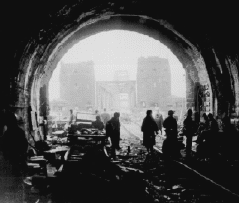
Credit: National Archives
As their contribution to help defeat the forces of evil and to win WW-II, the 15th FA Bn was in combat for 336 days and fired 151,000 rounds while providing direct fire support to the 2nd Infantry Division and general support to several other divisions. For their efforts and sacrifices the 15th FA Bn was awarded streamers for five major campaigns during WW-II including: Normandy; Northern France; Rhineland; Ardennes-Alsace; and Central Europe.
![]()
Streamer image: Institute of Heraldry
Additionally, the 15th FA Bn was awarded the Belgian Fourragere, and was cited in the Order of the Day of the Belgian Army for extraordinary combat action in the battle of the Ardennes and Elsenborn Crest. Individual decorations awarded to members of the 15th FA Bn during WW-II included: 6 Silver Star Medals; 91 Bronze Star Medals for Gallantry; 83 Bronze Star Medals for Meritorious Service; 20 Air Medals; and 170 Purple Hearts.
All of the honors earned by the 15th FA Bn and its members during WW-II did not come cheaply as twenty-nine (29) members of the 15th FA Bn were killed in action [WW-II Scroll of Honor]. The Indianheads of the Fighting Fifteenth had paid their dues - Again!
Written by: Dan Gillotti (15th Historian)

"Typical
Cannoneer of the 15th FA Bn
in France August 1944."
Photo:US Army Signal Corps
provided by Dan Gillotti
The
15th Field Artillery Battalion
in World War Two
By: Colonel Ed Hrdlicka
The 15th Field
Artillery Battalion left the USA and arrived in Northern Ireland late October
1943. The 15th was billeted near Armagh, at and around Markethill, a small
village. The Battalion HQ and staff and Battery commanders plus other officers
were housed in Gosford Castle, one of the oldest and largest castles in Ireland.
The Battalion trained here while in N. Ireland. Before we left N. Ireland we
were addressed and inspected by General Patton.
The 15th moved on
April 17th, 1944, embarked on the James T. Parker to our marshalling area at
Porthcawl in South Wales. After finishing tactical training, the Battalion was
billeted in a group of resort hotels along the Esplanade overlooking the Bristol
Channel, and began specialized training.
While in Porthcawl the
Battalion Commander, Lt. Col. Robert L. Cassibry, staff officers and Battery
Commanders were billeted in a large two-story house. I can't remember the name
of the lady who owned it. She remained at the home and was so very helpful in
"caring" for us. Often we would provide her with rations and she
would cook "home cooked" meals. I have never forgotten this! I am sure
this home is still there... All the people in Porthcawl were nice to all of us,
soldiers and officers -very helpful, always.
After a month of
preparation the 15th moved to Barry, south Wales for final staging in
anticipation of the coming invasion. Here the Infantry-Artillery combat teams
were made up. The 15th FA Battalion formed a combat team with the 9th Infantry
Regiment. It was here that we were addressed by the First Army Commander, Lt
General Omar Bradley and inspected by various General Officers.
The forward echelon of
the 15th moved by rail to board the US Army Transport George Goethals on June
2nd 1944, in Swansea harbor. The unit materiel and remainder of personnel were
loaded on the (Liberty ship) Charles Sumner. With the 2nd Infantry Division
assigned to follow the 1st and 29th Infantry Divisions landings in France, the
9th Combat team (9th Infantry-15th FA Battalion) received the mission of the
initial 2nd Division landing.
On June 7th 1944, D+1,
at 15.30 hours, the 15th Battalion commander, Lt Col. Cassibry, and
reconnaissance party, which included all the firing battery commanders, (A
Battery - Captain Ed Hrdlicka; B Battery - Captain Emil Meis; C Battery -
Captain Herbert Hartung) landed on the French coast at St. Laurent-sur-Mer
(Beach: Omaha, Easy Red.) With great success the Battalion moved into action
with extremely low casualties and began the Trevieres offensive. I lost, killed
in action, only one soldier on D+1.
I remained as A
Battery commander throughout the war, winding up in Losina, Czechoslovakia, near
Pilzen, on May 7th, 1945 and May 9th, 1945, VE Day, when war ended.
We had 336 days of
fighting, including five major campaigns:
1. Normandy
2. Brest
3. "Heartbreak Crossroads, the Ardennes"
4. Rhineland
5. Central Europe
I retired on Feb 1st
1970, in San Antonio, Texas - 30 years active service.
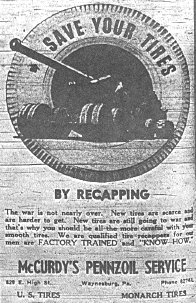
Tire advertisement from WW2
"While the Battle of
the Bulge couldn't have been won by artillery alone, it was the superhuman effort of the
artillery that prevented it from being lost on several occasions."
Lieutenant Colonel William
R. Jesse, 1944
Help build the Wall of Liberty memorial...
The landscaped park is intended to serve as the setting for the Wall of Liberty, honoring the memory of American soldiers who fought on the beaches of Utah and Omaha beaches, June 6, 1944, and throughout the European Theater of Operations. The first phase of the project will be to list the names of the original 66,000 contributors of the "Battle of Normandy Foundation," and also the names of American soldiers who died on D-Day.
Once this goal has been achieved, additional circular gardens may be erected to list the names of all Americans who served in the European Theatre of Operations WWII.
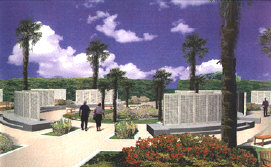
The proposed Memorial Park, which will be a counter friendly addition at UTAH BEACH, to the beautiful American Cemetery overlooking OMAHA BEACH at Collevile-sur-Mer.
For more details see: US WW2 Wall of Liberty Foundation
Visitors since March 7, 2001
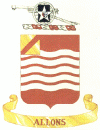
WW2 LINKS
______________________________________



